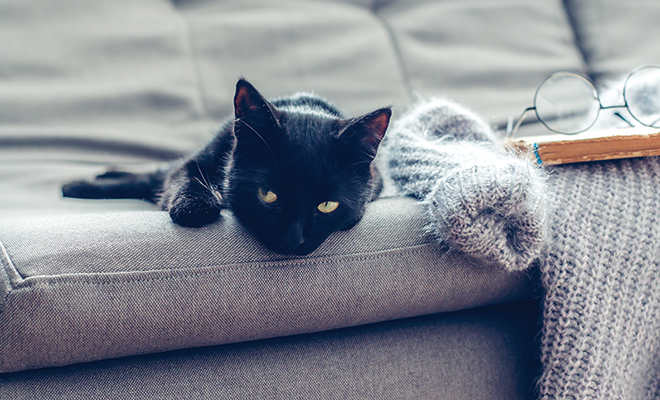
Cat Scratch Fever!
Just, please, Tigger, leave the upholstery alone!
Not that Tigger is the only one tearing up a chair or two. My goldendoodle baby has found a piece that he bites to relax. But he’s a little easier to deal with.
It’s a natural behavior that deposits scent from the cat’s claws to mark its territory. Some animal behaviorists think the scratch marks and claws left behind display confidence, and I tend to agree with that after watching my indoor/outdoor cat, Peanut, strut his stuff around the neighborhood cats who dared step into his territory. But outdoor cats are notorious for having brief life spans thanks to cars, dogs and FIV.
Goal 1
Divert her attention to a scratching post. Yes, elementary, but we know cats are particular and it’s trial and error here. Some cats prefer carpet, others like cardboard or sisal and you may have to offer a buffet of options until she chooses. Then there’s vertical or horizontal; if you go vertical, make sure it’s sturdy; some experts think the attraction of a chair or sofa is that it won’t tip over or move during scratching and stretching.
Remember the territory-marking component of the behavior. She’s left her scent on the upholstery, so do your best to remove it with an odor neutralizer.
Goal 2
Find the right spot for her diversion. Your favorite chair or a well-trafficked part of the house is likely where she gets the most attention and her aim is to mark it as her territory. Put the scratching post in the area where she’s scratching and spritz it with a catnip spray or even another herbal infusion. Many herbs are safe feline favorites; dill, oregano, parsley and rosemary can be sprinkled on a vertical or horizontal scratching post to enrich her indoor life.
When she uses the scratching post, reward her! Food, cuddles, soothing and encouraging words will make her go back to it. Like dogs, cat don’t connect punishment to their actions and harsh words will only make her anxious and fearful of you.
Goal 3
Protect the furniture, at least when guests aren’t present. Throw blankets can cover a scratch-prone area. Bases of furniture can be wrapped with sisal or a material such as Sticky Paws or double-sided tape. Your cat will learn, but there must be a nearby acceptable scratching spot to divert her to.
You can also harness the power of scent to keep your feline off the upholstery. A very diluted mixture of water and peppermint or citrus oil misted on the furniture may turn her around. Essential oils are toxic to cats, so verify this with your veterinarian. One suggestion is to rub cut lemons on the furniture, but check on a hidden area to make sure it won’t discolor the fabric.
Your veterinarian can also clip the nails, or you can learn to do it. Caution must be used to avoid cutting to the central quick, the blood supply to the growing nail.
Nail caps are a little high maintenance, requiring replacement every four to six weeks, but so much more preferable to the painful procedure of declawing, which many veterinarians refuse to do. A veterinarian may apply them, but depending on your cat’s temperament, caps can be a DIY solution. Proper application includes choosing the nail cap size that is a comfortable fit and shape for the cat’s nails and using enough glue to adhere, but not so much that it overflows during application. The glue should not touch the cat’s hair, nail bed or skin around the claws. Trim the nail slightly longer than a normal nail and leave space between the nail cap and the cat’s nail bed.
Nail caps allow the cat to stretch and extend the paws and claws, and the process of application keeps the nail healthy by removing dead layers of the nail sheath. That’s what she’s doing when she uses the scratching post or your upholstery. The first few applications might get her attention, and she might bite or pick at the caps; that’s normal and she will get used to them. Reinforce her positively with games and treats to distract her and keep her calm.
Caps aren’t a permanent solution, but they can be a positive option for older cat owners or those with thin skin or bleeding disorders. If you have antique furniture, quilts, carpets and fragile upholstery and can’t imagine not having a cat in your home, they’re a solution. Start early with a kitten to get her used to the manicured feeling!
Giving Up?
If you give in, let the cat have the chair. When guests visit, move it to another room out of sight. Stress less, love your cat more.
Sources: fearfreehappyhomes.com, merckvetmanual.com, nationalcatgroomers.com and rover.com.







